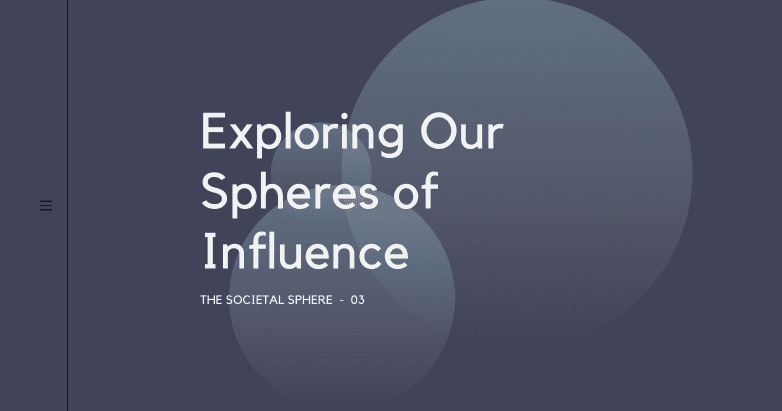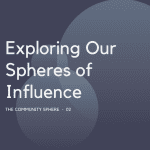
A few weeks ago, I began to explore my evolving sense that an embodied spirituality is one in which we develop the capacity to become faithful questioners and social poets. And for the past week or so, we have really focused on the social poet aspect of this: how do we engage the world around us as social poets?
Today, I’d like to explore the final sphere of influence – the social or societal sphere – and how we can engage it in this way.
(If you haven’t already, you can read the first two posts about the spheres of influence here and here. Starting with those will give more context for this post!)
A Recap: The Personal and Community Spheres of Influence
We’ve already covered that our personal sphere of influence includes those who are closest to us: our family members and close friends. (Note: if you have a hard or distant – emotionally or otherwise – relationship with a family member, they might not be in your personal sphere of influence. Use discernment!)
In general, these are the people in our life with whom proximity and trusting intimacy allow for our voice to carry weight.
Core Takeaway: In this sphere, the primary tools we have for engagement are loving (and sometimes tough) conversation and asking questions. Some examples might include:
-
- Calling in a family member or close friend on their unexamined privilege. (How to Do This)
- Exploring the negative (and positive) impacts of religious teachings.
- Showing support through physical, emotional, political, and spiritual changes.
Our community sphere of influence includes those who we engage with throughout our week in classrooms, workplaces, volunteer organizations, nonprofit boards, etc. These are the people with whom we don’t necessarily have tight relationships, but we do have frequent contact.
Core Takeaway: In this sphere, the primary tools we have for engagement are advocacy and asking questions. Some examples might include:
-
- Exploring the unstated beliefs and assumptions of the group and its leaders.
- Advocating for ongoing community education and training around issues of racism, sexism, and ableism in the workplace.
- Advocating for changes in order to create a more inclusive and human-honoring environment (changes might include those that are physical, programmatic, or personnel-related).
- Calling in leaders and colleagues when behaviors cause harm. (How to Do This)
- Supporting peers who have experienced harm within the community.
The Societal Sphere of Influence
For many of us, this is the space in which we come into contact with the broader society around us. This is where we can use our voices to make larger, systemic changes in our regions, countries, and world.
When we volunteer for political campaigns, attend marches and protests, engage in organized boycotts, and call our local and state representatives, we are operating in this sphere: we are coming together with others for the benefit of all of us.
The tools most prominent in this sphere are advocacy and protest (which are deeply related). In the face of injustice, we might advocate and organize for creative solutions, amplify the voices of those harmed, and challenge systems that cause physical, emotional, material, and spiritual damage.
This can also be the the most overwhelming sphere; if we only engage in this sphere, the injustices of the world can seem insurmountable and unending. Our societal history shows us that harm continues to morph and change and therefore protests and social action must continue to morph and change.
We never seem to quite get to the mountaintop when it comes to justice.
This is why it’s vital for us to build capacity to be social poets! In order to face the challenges of our world, there is a need for each of us individually and as communities to develop sustainable practices of resiliency in the face of the unknown and unending.
When is a time you’ve looked at an injustice and simply turned away or bowed your head in grief, knowing it is out of your power to change it?
Embodying a Holistic Approach to Harm
When I volunteered on a political campaign in 2014, I found out quickly how important it was to engage the societal sphere on a local level. Every door I knocked on, every protest I attended, every donation I collected: it had a clear purpose toward electing a grassroots community organizer into citywide office.
And yet, I also realized my life was entirely out of balance. The work I did in my societal sphere had no connection with my personal and community conversations. It was like I was compartmentalizing the ways in which I engaged the world.
It was a fragmented life.
So, how can our knowledge of these spheres lead to us embodying a more holistic approach to harm, life, and justice?
Listen and Recognize:
- Start local: begin to listen for where the harm is in your local area. Seek to understand the experience of harm by listening to those feeling it. Who and what is causing the harm? What is being asked for? This is a spiritual practice as much as it is a political and activist one.
- Make the social connection: What structures in our society are causing or perpetuating this harm? What economic, political, and social realities lead to this current experience?
- Make the communal connection: How is this harm being caused or perpetuated in your workplace, school, faith community, or other organization?
- Bring it home: What are ways you have contributed, knowingly or unknowingly, to this harm being caused? What systems or structures do you benefit from while this harm is being caused?
Listen and Participate:
Personal Sphere:
- How is this harm being experienced and/or perpetuated within this close and intimate space?
- How might you start, or continue, a conversation needed in order to move individual hearts and bodies toward justice?
- What is a tangible action people can individually or as a group take toward justice?
Community Sphere:
- In this space, who is already working on this issue? How can you collaborate and amplify their work?
- How can you support those in this space being caused by harm? (Learning this requires being in relationship with them and listening.)
- What conversations need to be had regarding this issue? Who needs to be “at the table?” Who has historically not been at the table?
- What are you willing to give up (power, rank, control) in order for change to happen?
Societal Sphere:
- What community groups are already working on this issue at a societal level? How can you support them?
- In what ways can you engage your network to amplify the voices of those harmed and those already working to reduce and end the harm?
- How might you leverage your voice to make an impact? What privileges do you have that you can use for justice?












